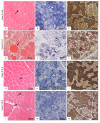Neuroacanthocytosis Syndromes in an Italian Cohort: Clinical Spectrum, High Genetic Variability and Muscle Involvement
- PMID: 33652783
- PMCID: PMC7996727
- DOI: 10.3390/genes12030344
Neuroacanthocytosis Syndromes in an Italian Cohort: Clinical Spectrum, High Genetic Variability and Muscle Involvement
Abstract
Neuroacanthocytosis (NA) syndromes are a group of genetically defined diseases characterized by the association of red blood cell acanthocytosis, progressive degeneration of the basal ganglia and neuromuscular features with characteristic persistent hyperCKemia. The main NA syndromes include autosomal recessive chorea-acanthocytosis (ChAc) and X-linked McLeod syndrome (MLS). A series of Italian patients selected through a multicenter study for these specific neurological phenotypes underwent DNA sequencing of the VPS13A and XK genes to search for causative mutations. Where it has been possible, muscle biopsies were obtained and thoroughly investigated with histochemical assays. A total of nine patients from five different families were diagnosed with ChAC and had mostly biallelic changes in the VPS13A gene (three nonsense, two frameshift, three splicing), while three patients from a single X-linked family were diagnosed with McLeod syndrome and had a deletion in the XK gene. Despite a very low incidence (only one thousand cases of ChAc and a few hundred MLS cases reported worldwide), none of the 8 VPS13A variants identified in our patients is shared by two families, suggesting the high genetic variability of ChAc in the Italian population. In our series, in line with epidemiological data, McLeod syndrome occurs less frequently than ChAc, although it can be easily suspected because of its X-linked mode of inheritance. Finally, histochemical studies strongly suggest that muscle pathology is not simply secondary to the axonal neuropathy, frequently seen in these patients, but primary myopathic alterations can be detected in both NA syndromes.
Keywords: McLeod syndrome; VPS13A gene; XK gene; chorea-acanthocytosis; neuroacanthocytosis syndromes.
Conflict of interest statement
The authors declare no conflict of interest.
Figures



Similar articles
-
Clinical Features and Novel Pathogenic Variants of Chinese Patients With McLeod Syndrome and Chorea-Acanthocytosis.Mol Genet Genomic Med. 2024 Sep;12(9):e70015. doi: 10.1002/mgg3.70015. Mol Genet Genomic Med. 2024. PMID: 39324427 Free PMC article.
-
XK is a partner for VPS13A: a molecular link between Chorea-Acanthocytosis and McLeod Syndrome.Mol Biol Cell. 2020 Oct 15;31(22):2425-2436. doi: 10.1091/mbc.E19-08-0439-T. Epub 2020 Aug 26. Mol Biol Cell. 2020. PMID: 32845802 Free PMC article.
-
XK-Associated McLeod Syndrome: Nonhematological Manifestations and Relation to VPS13A Disease.Transfus Med Hemother. 2022 Jan 25;49(1):4-12. doi: 10.1159/000521417. eCollection 2022 Feb. Transfus Med Hemother. 2022. PMID: 35221863 Free PMC article. Review.
-
Current state of knowledge in Chorea-Acanthocytosis as core Neuroacanthocytosis syndrome.Eur J Med Genet. 2018 Nov;61(11):699-705. doi: 10.1016/j.ejmg.2017.12.007. Epub 2017 Dec 16. Eur J Med Genet. 2018. PMID: 29253590 Review.
-
Identification of four novel mutations in VSP13A in Iranian patients with Chorea-acanthocytosis (ChAc).Mol Genet Genomics. 2024 Mar 22;299(1):39. doi: 10.1007/s00438-024-02111-y. Mol Genet Genomics. 2024. PMID: 38519717
Cited by
-
Neurodegenerative and Neurodevelopmental Roles for Bulk Lipid Transporters VPS13A and BLTP2.Mov Disord. 2025 Jul;40(7):1356-1368. doi: 10.1002/mds.30178. Epub 2025 Mar 28. Mov Disord. 2025. PMID: 40152532 Free PMC article.
-
Clinical Features and Novel Pathogenic Variants of Chinese Patients With McLeod Syndrome and Chorea-Acanthocytosis.Mol Genet Genomic Med. 2024 Sep;12(9):e70015. doi: 10.1002/mgg3.70015. Mol Genet Genomic Med. 2024. PMID: 39324427 Free PMC article.
-
Neuroacanthocytosis Syndromes: The Clinical Perspective.Contact (Thousand Oaks). 2023 Dec 10;6:25152564231210339. doi: 10.1177/25152564231210339. eCollection 2023 Jan-Dec. Contact (Thousand Oaks). 2023. PMID: 38090146 Free PMC article. Review.
-
Novel Presentation of McLeod Syndrome With Muscle Weakness and Biopsy Findings Indicative of Mitochondrial Dysfunction.J Clin Neurol. 2025 Mar;21(2):150-152. doi: 10.3988/jcn.2023.0253. J Clin Neurol. 2025. PMID: 40065457 Free PMC article. No abstract available.
-
A chorea-acanthocytosis patient with novel mutations in the VPS13A gene without acanthocyte.Neurol Sci. 2024 May;45(5):2057-2061. doi: 10.1007/s10072-023-07174-0. Epub 2023 Nov 21. Neurol Sci. 2024. PMID: 37985634 Review.
References
-
- Walker R.H., Jung H.H., Dobson-Stone C., Rampoldi L., Sano A., Tison F., Danek A. Neurologic phenotypes associated with acanthocytosis. Neurology. 2007;68:92–98. doi: 10.1212/01.wnl.0000250356.78092.cc. - DOI - PubMed
Publication types
MeSH terms
Substances
Supplementary concepts
LinkOut - more resources
Full Text Sources
Other Literature Sources

